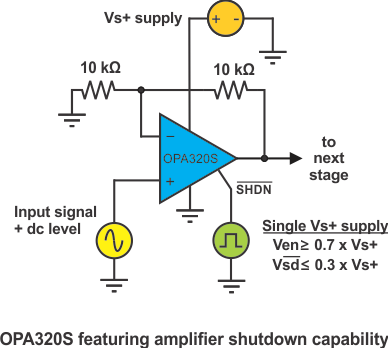Anyone who works with modern single-channel operational amplifiers, op amps, in their analog circuit designs are familiar with the 5 active device pins; the two inputs, the two supply pins and the output. These five pins accommodate the numerous applications where we apply op amps.
Following them is the next group having a sixth active pin function. Most often that additional pin functions as a shutdown, or conversely, a device enable pin. Shown below is the OPA320S that includes shutdown capability.
So what exactly is this shutdown/enable pin supposed to do?
Most often the purpose of the shutdown pin is to idle the amplifier function and reduce its power consumption. When the op amp is shut down it goes into a non-active mode where the quiescent current (Iq) is reduced by many orders of magnitude.
The OPA320S CMOS op amp, shown above, has a typical Iq of 1.5 mA with a 3.3 V supply level. Its power consumption is 4.95 mW when active. When in shutdown mode, however, the typical Iq reduces to 0.1 uA and the power consumption decreases to 330 nW - a decrease in power of 15,000:1.
The shutdown/enable pin makes switching between the two modes easy. One simply applies the correct voltage level on the pin required for the desired mode. The shutdown/enable levels for the OPA320S when using a single Vs+ supply are shown in the diagram.
Where users get into trouble with the shutdown function is making assumptions about what else the amplifier should do besides reducing power consumption. Probably the most common assumption is that the amplifier becomes a high impedance block at the inputs and output, with no internal conduction paths. Another is the amplifier will no longer have any effect on signals and circuits directly connected to its pins. One, or both, may be true but unless there is something in the data sheet stating the specific amplifier characteristics in shutdown mode then it may not be so!
Exactly how the op amp behaves during shutdown is dictated by its electrical design.
Some op amps having shutdown do, by virtue of their design, almost disappear electrically from the circuit. They draw miniscule supply current, their inputs and outputs appear as very high impedances and signals applied to them couple minimally through them. The “off” pins have little effect on circuit signals. This is often the case for modern, CMOS op amps.
Some op amps, especially some based on bipolar designs, may have input protection diode clamps that can be biased “on” when a large signal is applied to the amplifier output while it is in shutdown mode. In that case, the feedback resistor and diodes can provide a signal path from the output back to anything connected to the amplifier’s non-inverting input.
The OPA211 is an example of a precision bipolar op amp having shutdown capability and has the clamping diode protection in place across its inputs. The potential output-to-input signal path is illustrated in the OPA211 data sheet Fig. 45.
Even though an op amp may almost disappear during shutdown when dc levels are applied, ac signals applied to the pins may couple to unexpected points, or become distorted. This is especially true as their amplitude and/or frequency is increased. Each model of op amp should be evaluated in the application circuit where its shutdown mode behavior can be observed first hand.
It is best to seek an op amp where the data sheet spells out and fully discusses the shutdown behaviors. Don’t read anything into the data sheet regarding the shutdown mode behavior that isn’t stated!
Our forum has an old thread that touches on the topic of non-chopper CMOS op amps, here. Learn about TI’s entire portfolio of amplifier ICs and find technical resources.

